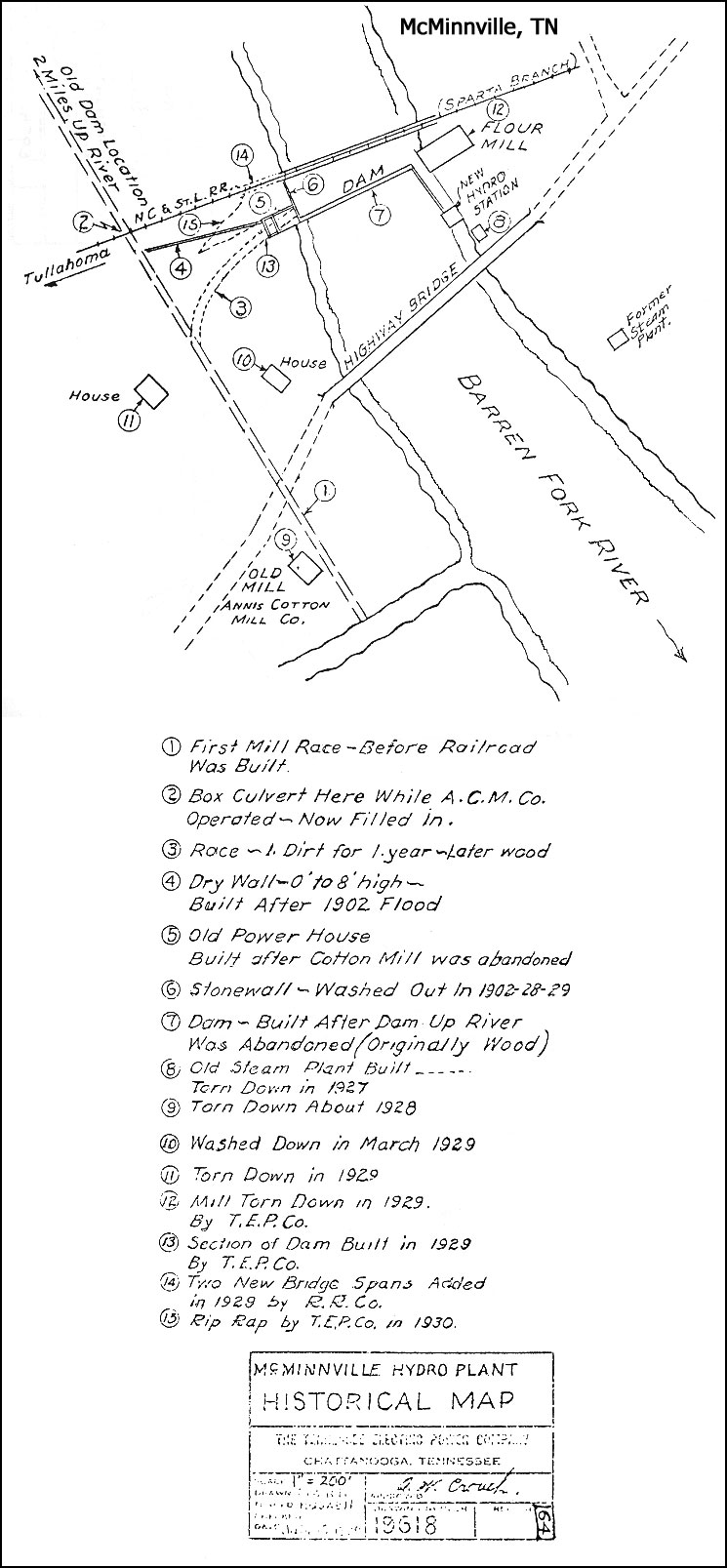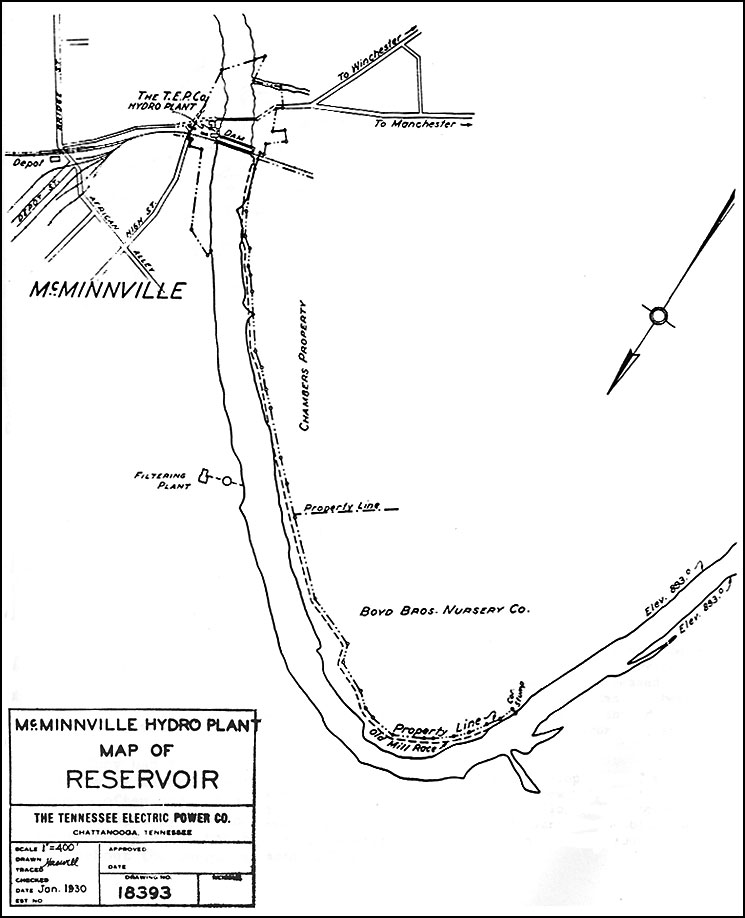|
Light & Power Companies in the Area Near Great Falls
Power House
Sparta Light & Power
Company
Stanton Dibrell and his associates, who
organized the Sparta Light & Power Co., selected a site in
Sparta on the Calfkiller River for a hydroelectric power plant,
just above the highway bridge on Hwy. 70 and not much over a
block from the Public Square.
In 1902 they purchased a 60 kilowatt single-phase generator from
the Fayetteville Steam Plant, a water wheel from Rome, Georgia,
and an American Ball steam engine from the old Read House in
Chattanooga. The latter was used for standby service as
the stream flow in the Calfkiller was very small in dry weather.
The equipment was installed in an old mill by
G.B. (Bun) Shawyer, who also
was the first operator.
Shawyer said that the equipment was all erected in accordance
with the blue prints that came with it but it just would not
work. He tore out all the wiring, worked all night using
his own ideas, and next morning the street lights in Sparta were
burning. Mr. Shawyer had worked for Mr. Walling at the old
steam plant in McMinnville. He later was in charge of all
water and ice plants with the
Tennessee Electric Power
Co.
The first plant burned in 1907. In 1909 the
Anderson and Tubb
Power Company bought out the old company and built a new
modern plant one mile downstream. A 6-foot concrete dam
was built at the site of the old Harriet Iron Works. It
diverted the river into an open flume which carried the water a
quarter of a mile downstream to a new power house. The
latter was about opposite the hillside site of a former cotton
mill. This layout took advantage of the Falls of the
Calfkiller. The plant operated till the Tennessee Electric
Power Co. sold out. Slag piles from the old iron works
were still visible at the dam site in the 1930's. The
plant together with the Sparta distribution system was purchased
by TEPCo. in January, 1925. The capacity of the plant was
180 kw.
The reproduction cost in January, 1927 was $115,944 which
included land at $10,000. The average annual generation
(1925-29) was 834,800 kw-hr.
|
Walling Light & Power Company
McMinnville
Mr. J. Walling organized the Walling
Light & Power Company in McMinnville prior to 1900. Power
was first supplied for street lights and some business
houses from dark to about 10 P.M. by a small steam plant. It
was not till late in 1907 that hydroelectric power was
available.
The first plant was a make-shift affair. A generator was
installed in the Falcon Flour Mill on the left bank of the
Barren Fork River. It was used for a few months until a new
plant was completed on the right bank of the river. A 200
kilowatt, horizontal generator was installed which with an
enlarged steam plant on the left bank served the town until
1923. A new modern plant with a 220 kilowatt vertical unit
was placed in operation on the left bank of the river.
The Tennessee Electric Power Co. purchased Mr. Walling's
interests in 1926 and continued operations but largely on a
standby basis after a transmission line was built from Rock
Island to McMinnville. |


|
The
Good Old Days
Note: The following was
taken from "System Control News" for February 1, 1973
published by the Power Dispatching Branch of the Tennessee
Valley Authority.
In our "Looking Back" to the
days of the small hydro plants we have found the
operators to be working
12-hour shifts. These long hours were not
limited to operators. The paragraph below
is quoted from
a talk by Arthur W. Crouch, "SideLights on the
History of the Tennessee Electric Power
Company,"
February 28, 1940.
Mr. Shawyer's work in the industry began in
1894. He installed the equipment in the original
Sparta
Hydro Plant in 1902, and served as its first
operator. In 1934, he is recorded as being the
Superintendent of Maintenance for the water and
ice plants that were
operated by TEPCo. |
"The operation of the
distribution system was comparatively simple in the good old
days. 'Bun' Shawyer used to
operate the entire town of McMinnville. He arose about
5:00 in the morning, helped with the chores and then started
on his daily round. He rode a bicycle with a basket of
tools in front, a box of fittings behind, a reel of wire on
the handle bars, and a ladder over his shoulder. He
trimmed street lights, wired houses, installed meters and
made necessary extensions. About 4:00 in the afternoon
he got a bite to eat and hurried down to the steam plant
where he fired boilers until about 10:00 at night. The
work was seven days ... not five."
Acknowledgement
The pages in the history of
hydro-electric development in Tennessee have been turning
rapidly. By 1930 many of the small plants had been
taken out of service and by 1940 practically all small
plants, both hydro, steam and oil had ceased operations and
many had been dismantled. Even a number of the small
dams had been removed. They are now only memories.
It is therefore fitting that we should acknowledge and give
full credit to those pioneers of the industry, promoters and
operators, many of whose names are now unknown.
They had the courage, faith and daring to undertake the
development of electricity by water power; they struggled
with and conquered many new problems; though often ridiculed
by their fellow men and harassed by the floods and storms of
nature, they had the perseverance and strength to push
forward in establishing an industry which has brought untold
benefits to factory, farm and fireside throughout the length
and breadth of Tennessee. |
|